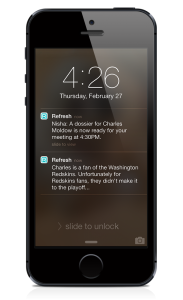Refresh is the app that seems a bit mystical when it presents you with a dossier (its phrase) about the person you are just walking up to meet. Mystical and maybe a wee bit creepy. But sometimes also so useful. Useful enough that I keep mentioning it to you even though it remains a US-only app.
And useful enough that yesterday’s Forbes roundup video of best productivity apps included it, though the presenters didn’t seem to glom onto the creepy mystical element so much. I’m just sensitive.
It’s also not quite useful enough to be as useful as you’d expect. I reviewed it months ago and forgot I had it until some many weeks later when it chimed up with one of these dossiers. But it does it for this person and not for that, it does it before this meeting and not that. And it hasn’t chimed a dossier at me in two months. Enough so that I forgot I still had it, until I got this email telling me about a new update:
There’s a new Refresh for you to try.
We updated the app you know and love to take advantage of new features in iOS 8. You can now install a Refresh widget in the Notification Center to see who you’re meeting each day, and insights display beautifully on any screen including iPhone 6 and iPad!
To install the new Refresh widget, update your app and then click “Edit” on the bottom of your Today screen. Click the green plus next to Refresh and you’re good to go!
Refresh now available as a Notification Center widget! – email from Bhavin Shah, Refresh (21 October 2014)
I am slightly confused by this: the Refresh app itself says you need to update to the new version and then delete the old. Cool. Happens all the time: a brand new app downloads and until you delete the old one, you’ve got two on your iPhone and it all ends in hilarious consequences. But this time, once I’d tapped its update button, there was no second copy. Can’t see where the old one is to delete. Actually would be hard-pressed to tell you for sure that what I have is the new version, except that it does have that bit in notification centre.
Which on my iPhone right now looks thisaway:

I like that it’s Yasmin I’m meeting because she’s an author who routinely fakes all her personal information on Facebook and Twitter and Linkedin so that description of her is nonsense.
If you’re in the US or, like I do, have a US iTunes account then you can get Refresh here and it’s free.

